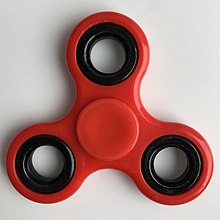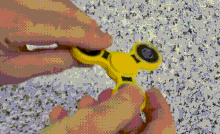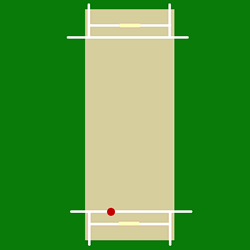
Off spin is a type of finger spin bowling in cricket. A bowler who uses this technique is called an off spinner. Off spinners are right-handed spin bowlers who use their fingers to spin the ball. Their normal delivery is an off break, which spins from left to right when the ball bounces on the pitch. For a right-handed batsman, this is from his off side to the leg side. The ball breaks away from the off side, hence the name 'off break'.

A yo-yo is a toy consisting of an axle connected to two disks, and a string looped around the axle, similar to a spool. It is an ancient toy with proof of existence since 440 BC. The yo-yo was also called a bandalore in the 17th century.
James Hargreaves was an English weaver, carpenter and inventor who lived and worked in Lancashire, England. Hargreaves is credited with inventing the spinning jenny in 1764.

A ball bearing is a type of rolling-element bearing that uses balls to maintain the separation between the bearing races.

Samuel Crompton was an English inventor and pioneer of the spinning industry. Building on the work of James Hargreaves and Richard Arkwright, he invented the spinning mule, a machine that revolutionised the industry worldwide.

Pet Rock is a collectible toy made in 1975 by advertising executive Gary Dahl. They were rocks packaged in custom cardboard boxes complete with ventilation holes and straw bedding imitating a pet carrier. The fad lasted about six months, ending after a short increase in sales during the Christmas season of December 1975. Although by February 1976 they were discounted due to lower sales, Dahl sold over one million Pet Rocks for $4 each, and became a millionaire.

Levitron is a brand of levitating toys and gifts in science and educational markets marketed by Creative Gifts Inc. and Fascination Toys & Gifts. The Levitron top device is a commercial toy under this brand that displays the phenomenon known as spin-stabilized magnetic levitation. This method, with moving permanent magnets, is quite distinct from other versions which use changing electromagnetic fields, levitating various items such as a rotating world globe, model space shuttle or VW Beetle, and picture frame. 750,000 units of the top were sold from 1994 through 1999.
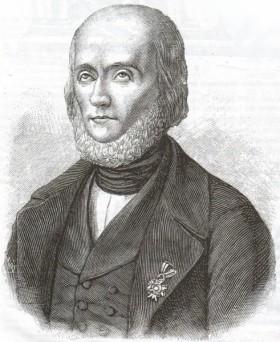
Philippe Henri de Girard was a French engineer and inventor of the first flax spinning frame in 1810, and the person after whom the town of Żyrardów in Poland was named. He was also the uncredited inventor of food preservation using tin cans.
John Kay was an English inventor best known for the development of the spinning frame in 1767, which marked an important stage in the development of textile manufacturing during the Industrial Revolution. Born in Warrington in Lancashire, England, Kay was at least the co-constructor of the first spinning frame, and was a claimant to having been its inventor. He is sometimes confused with the unrelated John Kay from Bury, Lancashire, who had invented the flying shuttle, a weaving machine, some thirty years earlier.

Self-stimulatory behavior, also known as "stimming" and self-stimulation, is the repetition of physical movements, sounds, words, moving objects, or other behaviors. Such behaviors are found to some degree in all people, especially those with developmental disabilities such as ADHD, as well as autistic people. People diagnosed with sensory processing disorder are also known to potentially exhibit stimming behaviors.

A timeline of United States inventions encompasses the ingenuity and innovative advancements of the United States within a historical context, dating from the Contemporary era to the present day, which have been achieved by inventors who are either native-born or naturalized citizens of the United States. Patent protection secures a person's right to his or her first-to-invent claim of the original invention in question, highlighted in Article I, Section 8, Clause 8 of the United States Constitution which gives the following enumerated power to the United States Congress:
To promote the Progress of Science and useful Arts, by securing for limited Times to Authors and Inventors the exclusive Right to their respective Writings and Discoveries.

Spin-stabilized magnetic levitation is a phenomenon of magnetic levitation whereby a spinning magnet or array of magnets is levitated via magnetic forces above another magnet or array of magnets, and stabilised by gyroscopic effect due to a spin rate that is neither too fast, nor too slow to allow for a necessary precession.

An office toy is a novelty item typically placed on the desk of a corporate executive or other office worker. They have no work-related function, but are often intended to provide decoration or pleasure, relieve stress or inspire creativity. The Newton's cradle is a classic example of an office toy.

Fidgeting is the act of moving about restlessly in a way that is not essential to ongoing tasks or events. Fidgeting may involve playing with one's fingers, hair, or personal objects. In this sense, it may be considered twiddling or fiddling. Fidgeting is commonly used as a label for unexplained or subconscious activities and postural movements that people perform while seated or standing idle.

Waboba is an international outdoor toy and sporting goods brand headquartered in Stockholm, Sweden with offices in Atlanta, Georgia and Guangzhou, China. Waboba is most known for its invention of balls that bounce on water, the high bouncing Moon ball, and the Wingman silicone flying disc. The company specializes in beach and backyard toys and games. The slogan used in advertising is Keep Life Fun. The name Waboba is a registered trademark and many of its products are internationally patented.

The Fidget Cube is a fidget toy designed by Matthew and Mark McLachlan, brothers and co-founders of the US design studio Antsy Labs. It has fidget tools on all sides: a toggle switch, gears, a rolling ball (marble), a joystick, a spinning disk, a worry stone, and five buttons. It may help users with ADHD focus. It can also help kids with autism and anxiety calm down or focus.
A squishy is a type of soft toy made of a specially formulated soft polyurethane foam, that slowly returns to its original shape after being squeezed. Squishies are manufactured into many different shapes and sizes, such as animals, fruits, and food items. They are often scented to match the object represented. The toy is also called kawaii squishy, kawaii meaning "cute" in Japanese.

A Pop-It is a fidget toy consisting of a usually-brightly colored silicone tray with poppable bubbles, similar to bubble wrap, that can be flipped and re-used. They come in a variety of colors, shapes, and sizes, and even come in wearable formats. It is marketed as a stress-reliever and rose in popularity in the spring of 2021 due to TikTok influencers as well as boredom and stress attributed to the COVID-19 pandemic.
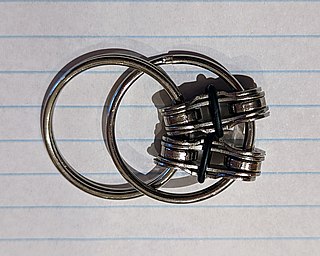
A fidget toy or fidget is typically a small object used for pleasant but purposeless activity with the hands. Some users believe these toys help them tolerate anxiety, frustration, agitation, boredom, and excitement. They are also commonly used by those with sensory difficulties.
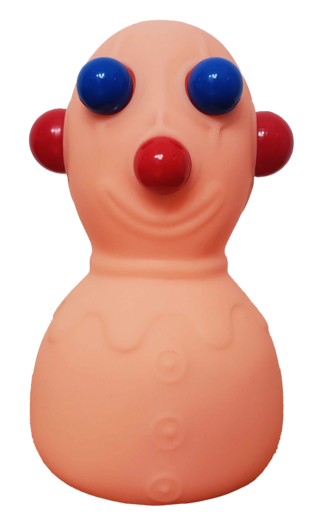
Panic Pete, also known as Jo-Bo, Obie, The Martian Popping Doll, The Martian Popping Thing, Popping Martian or Bug-Out Bob is a novelty rubber squeeze toy invented by John M. Auzin.
